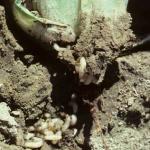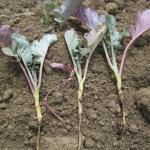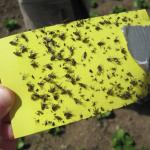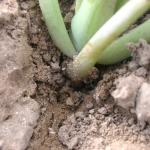Cabbage Root Maggot
Delia radicum
Identification:
Cabbage root maggot (Delia radicum) flies are delicate, hump-backed gray-brown flies, about 5-7 mm long. Onion, seedcorn and cabbage maggot flies are difficult to distinguish with the naked eye, but each will only be found on and near their appropriate crop family. Small (⅛”), white, bullet-shaped eggs are laid in soil. Maggots are white and legless and can be found in and around roots.
Life Cycle:
Life cycle. Cabbage root maggots overwinter as small brown pupae in the soil near roots of fall brassica crops where the larvae fed. Adults emerge in spring and can travel up to a mile in search of host plants. Eggs are laid in the soil at the base of the stem of host crops. Cool, moist soil conditions favor survival of the eggs, and soil temperatures that exceed 95°F in the top 2-3 inches will kill them. Larvae feed on roots and pupate in the soil. A late summer flight (late August, early September) may damage fall root crops. There are 3-4 generations per year in central New England.
Onset of Spring Flight. A good indicator of cabbage maggot flight is blooming of the common roadside weed, yellow rocket or wintercress (Barbarea vulgaris); good photos can be found at the online UMass Weed Herbarium.
Cumulative growing degree days (GDD) and indicator plants can be used to more specifically pin-point activity of cabbage maggot fly in your area. Many GDD models are base 50°C, but because cabbage root maggots are active at lower temperatures, GDD models should be base 4°C. NEWA has cabbage maggot models and growing degree day information here. Choose your state and the weather station closest to you. The resulting report indicates daily and cumulative GDD using the base temperature 4°C.
There is also GDD forecasting functions on the NEWA site for Connecticut, Massachusetts, and New York. Find a station near you and look at the last column for 4°C base T. You will see daily GDD forecasts for the coming week. This may be useful for determining whether pre-treatment or post-treatment would be most effective for your transplants.
Although cabbage root maggot, onion root maggot, and seedcorn maggot flies look almost identical, the peak flight for each pest occurs at different GDDs.
| Peak Flight | Seed Corn | Onion | Cabbage |
| 1st gen |
360 |
735 | 452 |
| 2nd gen | 1080 | 1752 | 1261 |
| 3rd gen | 1800 | 2975 | 2176 |
| 4th gen | - | - |
3014 |
| % Emergence | Accumulated GDD (Base T = 4°C) |
| 1st Emergence | 161 ± 8.1 |
| 25% | 204 ± 2.8 |
| 50% | 251 ± 7.9 |
| 75% | 304 ± 36.6 |
| 95% | 387 ± 7.7 |
Crop Injury:
Brassicas grow well in cool spring conditions and need an early start to reach maturity at the desired time. However, this leaves them vulnerable to the spring flight of cabbage maggot flies. Being aware of when spring flight occurs and being proactive with preventative control measures are key to getting the crop through the May flight period.
Larvae feed on roots and can completely destroy the root system. The first sign of a problem is wilting of the plant on sunny days and yellowing or purpling of outer leaves. Later, plants collapse, wilt down, and die. On inspection of the root area you may find the legless white maggots feeding, the small brown, oblong pupae, or tunnels from maggot feeding. In brassica root crops such as turnips, radishes, and rutabaga, maggot feeding tunnels on or in the root render it unmarketable.
Monitoring & Thresholds:
Monitoring for adults. Yellow sticky cards attract adult flies and can be deployed in or slightly above the canopy (see photo at top of page). Check and change cards every 3-5 days.
Monitoring for eggs. If you have transplants hardening off in a cold frame or outdoors, flies may find them and lay eggs in the flats. To check for eggs in the field or in flats, look for the ⅛-inch long, torpedo-shaped white eggs that are laid along the stem, or in and on the soil near the stem of young transplants. A pencil point or knife helps stir the soil to look for them. Field scout by checking 25 plants, in groups of 2-5 plants, scattered around the field. If you find an average of 1 egg/stem or more, significant crop damage is likely. Eggs may be more abundant in wetter areas of the field. Egg numbers may build up rapidly after the first eggs are seen. Scout successive plantings. Apply a soil drench 2 to 3 days after finding an average of one egg/plant.
Cultural Controls & Prevention:
- Rotate crops to keep maggot populations low; greater distances are more effective. Rotate spring crops to fields that were not planted with fall brassicas.
- Delay planting until after first flight is done (usually mid-May, depending on GDDs) and soil temperatures are high enough to kill eggs (95°F). Planting in late-May into June is generally safer than in the first half of May.
- Cover recently seeded or transplanted crops with floating row covers as a barrier against cabbage root maggot flies. Place the cover as soon as the transplants are set. Do not use where brassicas were grown last year, as pupae left in the soil could emerge under the cover. Place cover over the crop at the time of seeding or transplanting and seal the edges with soil. Replace cover after weeding operations. As soil temperatures rise, first flight ends, and crops grow large, covers can be safely removed.
- Use production methods that favor vigorous growth so that plants can compensate and outgrow moderate amounts of root injury. For information on production methods, visit the New England Vegetable Management Guide website.
- Cultivate vigorous brassica crops so that soil is brought up around the stem to encourage adventitious root formation. This can help compensate for root loss even if maggots are present.
- Till under fall crop residue to expose and help reduce populations of overwintering pupae.
Chemical Controls & Pesticides:
Direct application of insecticides to the root zone is considered the most effective means for controlling maggot damage. Insecticides should be applied as a narrow band with enough water to penetrate the root zone. For direct seeded crops, apply insecticides over the row. For transplanted crops, spray should be directed to the base of the plant. A wider spray band reduces the concentration of the insecticide over the row and therefore decreases its effectiveness. Some materials may be applied as a transplant tray drench or in transplant water, or in-furrow before or during seeding or transplanting. Be sure to read the label of any material you choose to use to determine which methods it is labeled for.
Scout each successive seeding or planting to determine whether treatment is required. Cabbage maggot eggs are very sensitive to high soil temperatures (above 95°F), and will die if they are exposed to these temperatures for several days in a row. Generally these soil temperatures are reached by late May/early June, unless there has been excessive rain, which has a dramatic cooling effect on the soil. This means that under high soil temperatures there is no need to spray for this pest.
Products labeled for use against cabbage root maggot:
Check labels for specific crops allowed and other restrictions, including options for soil drench in direct-seeded and transplanted crops and transplant drench. Target the seed furrow or the base of the plants after transplanting, and use at least 100-200 gallons of water per acre to help the insecticide penetrate to the root zone.
- Chlorpyrifos (Lorsban 4E, 75 WG, or 15G) (organophosphate - Group 1B)
- Diazinon (Diazinon AG500) (organophosphate - Group 1B)
- Cyantranilprole (Verimark for soil application, Exirel for foliar application) (diamide - Group 28)
- Ecotrol G is a plant-based granular with several aromatic oils that may have repellent effects against cabbage root maggot. It is allowed in USDA certified organic production. This product is exempt from pesticide registration and so does not have an EPA number of official label.
Biological Controls:
Natural enemies. Soil-dwelling beetles, including ground beetles (carabids) and staphylinid beetles, feed on cabbage maggot eggs, larvae, and pupae and can cause high levels of mortality. One staphylinid species, Aleochara bilineata, also parasitizes maggot larvae and has been shown to respond to chemicals given off by plants that suffer maggot damage. Because these soil-inhabiting beetles are susceptible to insecticides, broadcast soil insecticide treatments should be avoided. Other natural enemies including parasitic wasps and predatory mites. Naturally-occurring fungal diseases occasionally will reduce onion maggot numbers, particularly when flies are abundant and relative humidity is high. During a fungal epidemic dead, diseased flies, can be seen clinging to the highest parts of plants along field edges.
Nematodes for biological control. Soil application of the entomopathogenic nematode Steinernema feltiae has shown efficacy against cabbage maggot in trials even at low soil temperatures 50°F/10°C). Apply by suspending infective juvenile nematodes in water and treating transplants prior to setting in the field (as a spray or soaking drench), or in transplant water used in the water wheel transplanter, as a drench after transplanting, or a combination of pre-plant and post-plant applications. Post-plant treatments are likely to be needed if maggot flight begins >1 week after transplanting. Rates of 100,000 to 125,000 infective juveniles per transplant have been shown to be needed to achieve reduction in damage. Nematodes need a moist soil environment to survive.
Crops that are affected by this insect:
- Cabbage, Broccoli, Cauliflower, and Other Brassica Crops
- Carrot and Parsnip
- Radish
- Rutabaga and Turnip
Sources:
GDD of peak flights: Seedcorn - University of Minnesota; Onion - NYS NEWA; Cabbage: -NYS NEWSA, Jyoiti & Shelton
The Center for Agriculture, Food and the Environment and UMass Extension are equal opportunity providers and employers, United States Department of Agriculture cooperating. Contact your local Extension office for information on disability accommodations. Contact the State Center Director’s Office if you have concerns related to discrimination, 413-545-4800 or see ag.umass.edu/civil-rights-information.



